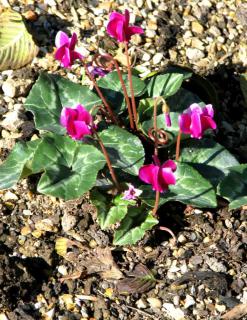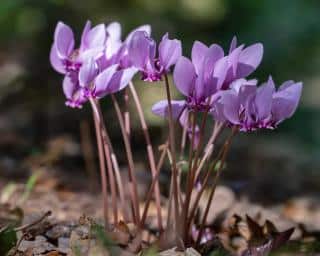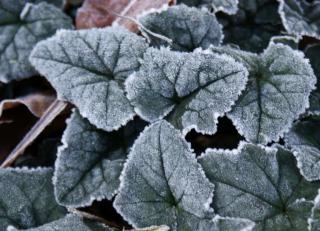

Ivy-leaved cyclamen is distinct from common florists’ cyclamens because of its fall blooming and its perennial life cycle.
Instant Ivy-leaf cyclamen facts
Name – Cyclamen hederifolium
Synonym – Cyclamen neapolitanum
Family – Primulaceae
Type – bulb/tuber
Height – 4 to 6 inches (10 to 15 cm)
Exposure – part shade, forest underbrush
Soil: light and well drained – Flowering: end of summer, fall
It is recommended to plant the cyclamen bulbs in spring, at the end of summer or at the beginning of fall.
 Favor partially shaded areas such as under a tree or along the side of a house on the sides facing East or North.
Favor partially shaded areas such as under a tree or along the side of a house on the sides facing East or North.It can be set in a pot, garden box and also in semi-shaded flower beds.
In any case, only superficial cover is needed for the bulb, with garden earth blended with soil mix.
For cyclamen purchased with flowers already, check that there are new buds forming, this will ensure the blooming will last longer.
Sowing is quite easy. Simply recover seeds when the capsules open up and put them in nursery pots with soil mix.

Natural watering when it rains should be enough, except in case of strong heat or long-lasting dry spells.
If the summer was quite dry and you feel that your cyclamen have trouble rising up, simply help them along by watering a bit.
For spectacular blooming, add flower plant fertilizer once a week.

Together with Cyclamen persicum, ivy-leaved cyclamen is one of the most commonly sold cyclamen sub-species.
Since it has been cultivated for nearly two centuries, there are now many different cultivars and varieties. An odd English name for the plant is “sowbread”, not because the tubers resemble a loaf of bread (they’re toxic!) but because wild pigs were said to love rummaging around the soil to find them.
Sadly, many of them have lost any fragrance they might have had in the wild. This is because breeders usually aimed for different flowers or shapes of leaves.
In ancient biblical times, cyclamen flowers and tubers were used to prepare incense. It was used in a religious context for major events. Learn more about the links between cyclamen and religion.
Read also:
Amending the soil with special “flower plant” organic fertilizer will strongly increase growth and blooming of the plant.
Ivy-leaved cyclamen will do great as part of an indoor plant wall, especially if in a spot that gets a bit cooler in winter. Lean-ins and verandas are perfect.